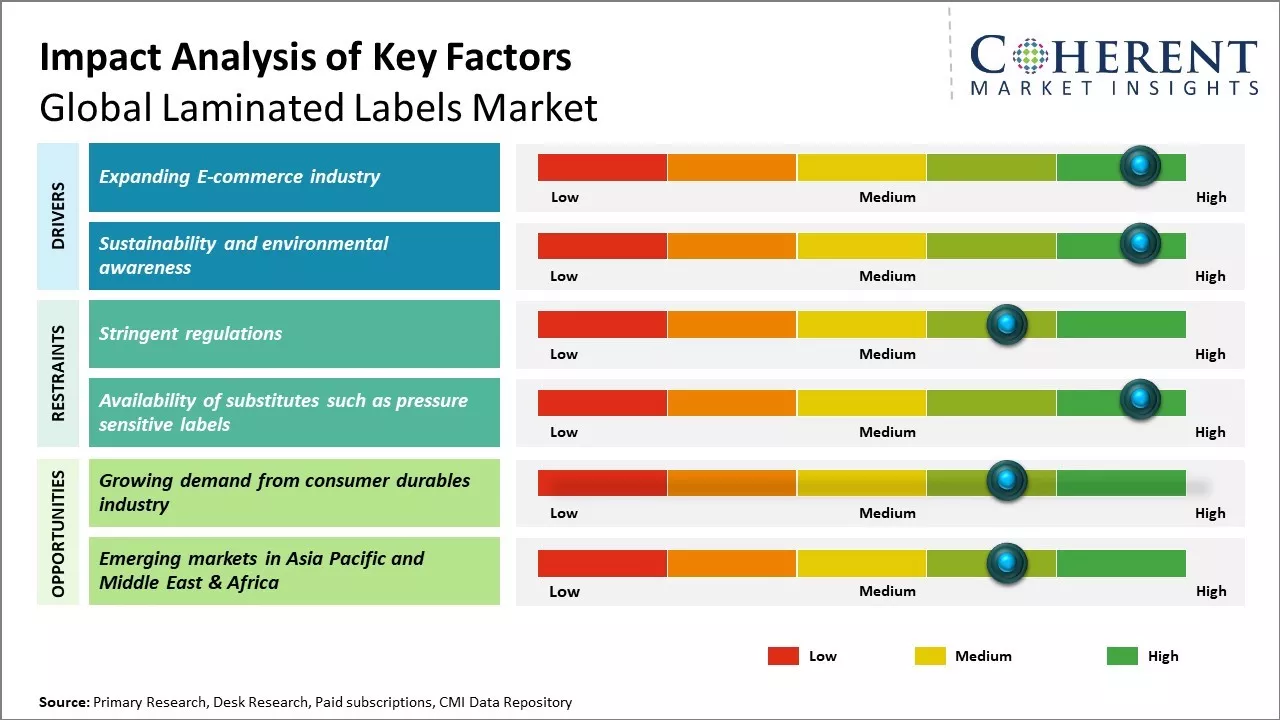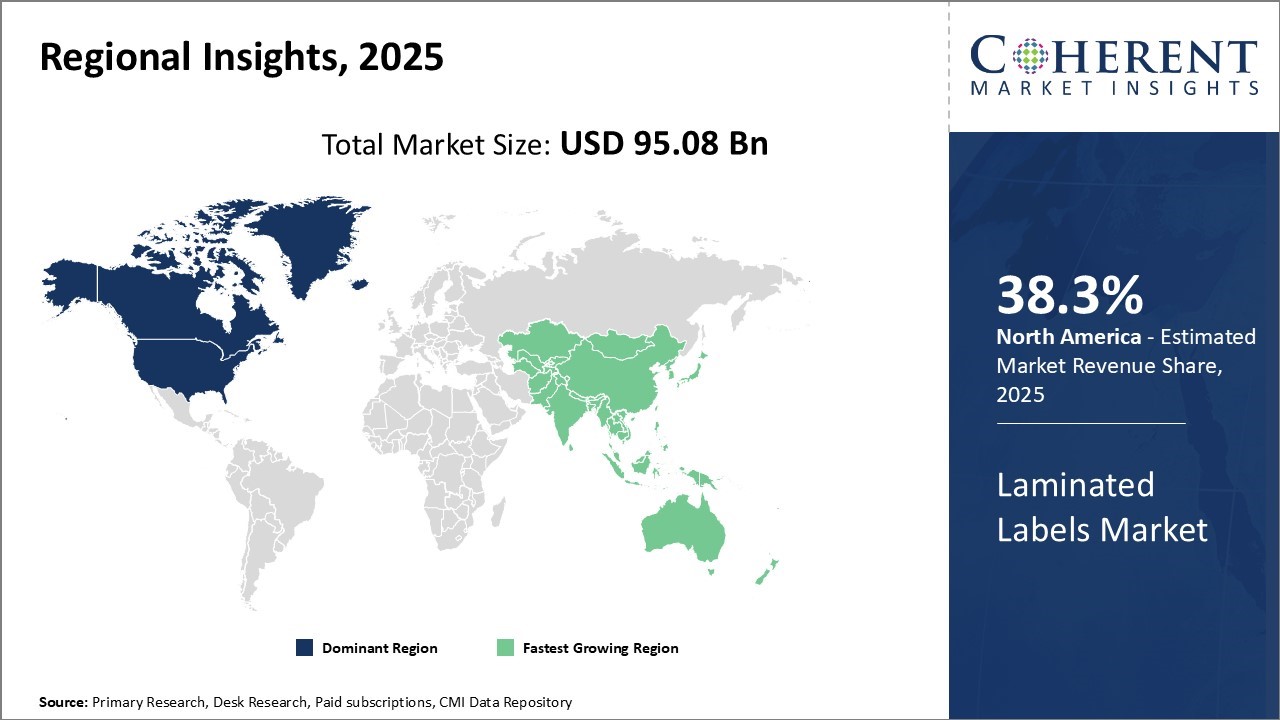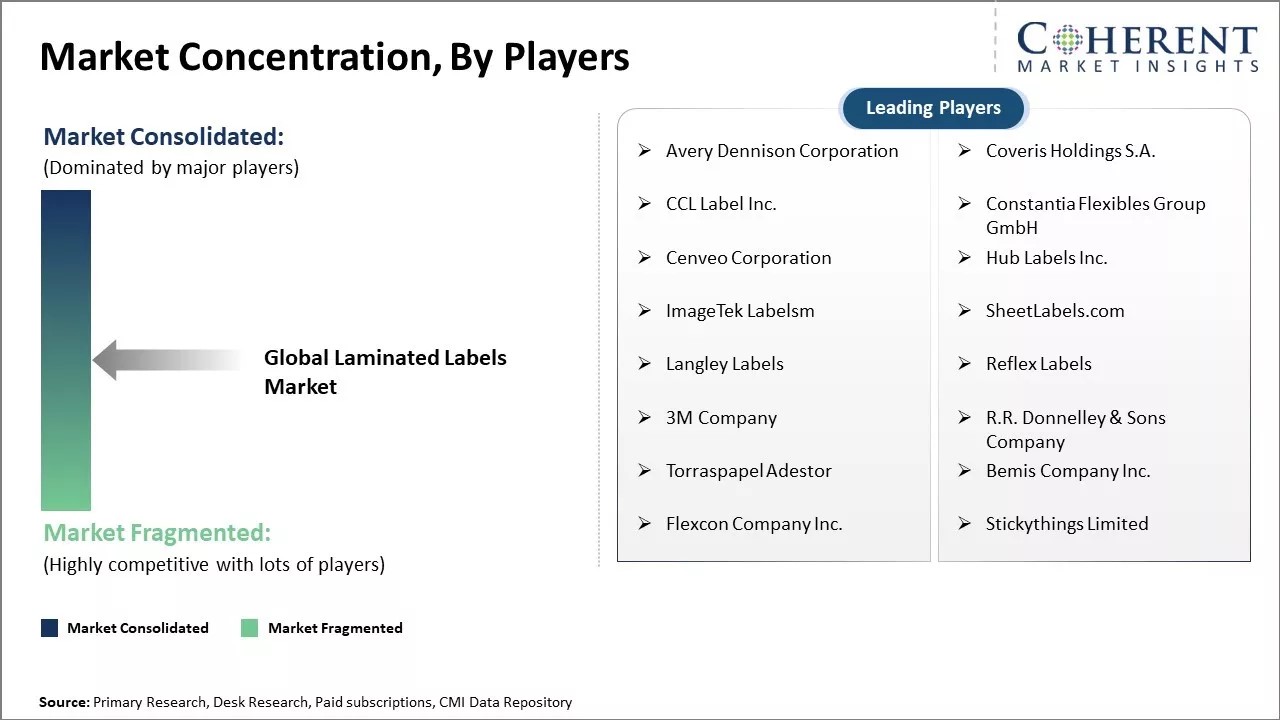The laminated labels market share is estimated to be valued at USD 95.08 Bn in 2025 and is expected to reach USD 132.99 Bn by 2032, exhibiting a compound annual growth rate (CAGR) of 4.9% from 2025 to 2032.

To learn more about this report, Download Free Sample
The market has been witnessing steady growth on account of increasing demand from various end-use industries such as food & beverages, cosmetics & personal care, pharmaceuticals, and homecare & toiletries. The laminated labels market is expected to witness significant growth during the forecast period. This is attributed to the growing demand for high-quality laminated labels from industries such as food & beverages, cosmetics, pharmaceuticals and homecare. Laminated labels provide enhanced protection and visibility compared to traditional labels and are becoming increasingly popular. Rising consumption of packaged products is also fueling the laminated labels market demand globally, as manufacturers seek durable and visually appealing labeling solutions.
|
Current Event |
Description and its Impact |
|
Regulatory and Environmental Pressures |
|
|
Consumer Behavior and Sustainability Demands |
|
Uncover macros and micros vetted on 75+ parameters: Get instant access to report
The integration of Internet of Things (IoT) technology is reshaping the laminated labels market, enhancing functionality, traceability, and user interaction across industries. Traditionally valued for durability and protection, laminated labels are now evolving into smart labels that offer real-time data and connectivity.
Brother International (India) Pvt Ltd is at the forefront of this technological shift, launching its latest IoT-enabled label printers. These advanced devices combine smart connectivity with robust printing capabilities, catering to industries that demand both performance and intelligence. The innovative label printers are designed to work with durable laminated labels that withstand harsh environments—offering resistance to abrasions, water, spills, heat, and cold.
In terms of material type, polypropylene is expected to contribute 36.0% share of the laminated labels market in 2025, owing to its durable yet affordable nature. Polypropylene labels can withstand challenging conditions such as moisture, chemicals, and wide temperature variations, making them suitable for a variety of product applications. They maintain their structure and print clarity for extended periods of time without fading, peeling, or cracking. Moreover, polypropylene films are cost-competitive compared to other materials such as polyester and vinyl. The lightweight and flexible properties of polypropylene also reduce logistics and storage costs. Its recyclability has further boosted adoption among brands aiming for sustainable packaging.
In March 2024, Toppan Inc. and India’s Toppan Speciality Films (TSF) introduced GL‑SP, a groundbreaking biaxially oriented polypropylene BOPP‑based barrier film, into production at their integrated Indian facility. As part of Toppan’s GL BARRIER series, GL‑SP offers high-performance oxygen and moisture protection while maintaining transparency and reducing plastic usage. It is ideal for sustainable mono-material packaging of dry goods. This fully localized, end-to-end process from resin formulation to final film which promises enhanced quality control, shorter development cycles, and reduced lead times.
In terms of printing technology, flexographic printing is expected to contribute 45.9% share of the laminated labels market in 2025, owing to its flexibility and high production efficiency. Flexographic printing can be used to print on various label materials and shapes at high speeds of over 200 meters per minute. It allows the reproduction of images with fine details and textures on a range of substrates. Moreover, flexographic presses have a quick changeover time between different jobs, enabling swift switching between label designs and fast turnarounds. Flexographic printing requires minimal makeready time and waste production, keeping per unit costs low even for short print runs. Its flexibility suits the mass customization requirements of numerous end-use industries. Therefore, flexographic printing has become the go-to technology for high-volume laminated label decoration.
In January 2025, At PrintPack India 2025, Line O Matic unveiled its latest innovation: the STM 125 automatic reel‑to‑reel flexographic printing machine. Designed for packaging converters, paper bag and cup manufacturers, the STM 125 delivers a robust web speed of 200 m/min, supports reel widths from 400–1,250 mm, and features a 1,200 mm print width with a chamber‑doctor inking system and double‑blade metering.
In terms of application, food & beverages is expected to contribute 38.1% share of the laminated labels market in 2025, owing to the versatile information requirements of this industry. Food and beverage labels need to feature extensive ingredient lists, nutrition facts panels, brand logos, barcodes, and various compliance declarations to educate and communicate with consumers. Laminated labels aptly meet these needs through their multicolor and multi-layered structures which allow the inclusion of printed booklets, additional overlays, and specialty papers. Their durability ensures the label information remains intact throughout the product's shelf life. Laminated labels also facilitate extended content while maintaining a small footprint ideal for food and drink items. Thus, their versatility in conveying comprehensive product data have made laminated labels the preferred labelling solution for the food and beverage industry over other alternatives.
In June 2025, Lecta Self‑Adhesives has launched its Adestor Gloss GP PFAS‑free labels, fabricated with C011032-certified paper, marking a significant step toward safer food packaging. The new labels, designed for meats, dairy, and other food items, eliminate per- and polyfluoroalkyl substances (PFAS), aligning with environmental regulations and consumer safety concerns. This is further propelling the laminated labels market share.

To learn more about this report, Download Free Sample
North America dominates the global laminated labels market currently. The region is expected to account for 38.3% of the market share in 2025. With a well-established packaging industry, the region has widespread usage of laminated labels across various end-use industries such as food, beverages, pharmaceuticals, and personal care. Stringent government regulations regarding product information and branding have further encouraged brand owners to utilize feature-rich laminated labels. For instance, at Labelexpo Americas 2024, major suppliers like Henkel demonstrated FDA-approved pressure-sensitive adhesives designed for food-safe laminated labels, highlighting how regulatory compliance enhances product safety and shelf stability. Meanwhile, the presence of global leaders in label manufacturing adds to North America's prominence. The region also has a culture of packaged food consumption along with technological advancements, providing an impetus to laminated label consumption.
Asia Pacific is anticipated to be the fastest growing region in laminated labels market during forecast period. With improved economic conditions and changing consumer lifestyles, the demand for packaged goods has increased manifold in the region's developing nations. This has prompted numerous global brands to enter new markets and establish production bases. Subsequently, labeling requirements have grown aggressively. In addition, regional manufacturers are leveraging low-cost manufacturing advantages to cater to both domestic and international customers. A recent example includes Huhtamaki’s expansion in India, where it launched a new line of pressure-sensitive laminated labels to support rising demand in the FMCG and personal care sectors. This has augmented Asia Pacific's standing as an export and trading hub for self-adhesive labels. The growing middle-class population further amplifies opportunities for value-added laminated labels. This is further proliferating the laminated labels market demand.
The U.S. laminated labels market continues to surge across food & beverage, personal care, and pharmaceutical sectors, driven by performance needs and regulatory compliance. Recently at Labelexpo Americas 2024, UPM Raflatac unveiled its “Carbon Action” and “Forest Film” labels including ISCC‑certified, plastic‑reducing materials that offer waterproof, chemical‑resilient surfaces suited for consumer goods packaging. These innovations reflect brand priorities for shelf-ready visual appeal and FDA-mandated durability, essential when labels must remain legible and intact across refrigeration, moisture, and transit. Meanwhile, e-commerce giants and direct-to-consumer brands increasingly rely on laminated polypropylene for high-graphic, tear-proof shipping labels, ensuring product information and branding don’t get compromised during transit. Altogether, these trends illustrate how U.S. market is developing from regulatory frameworks to retail innovation are fueling growth and investment in laminated label applications.
Germany’s demand for laminated labels is being driven by the nation’s powerhouse sectors and industry including automotive, and luxury packaging, each seeking high-performance and compliance-driven solutions. In the automotive and industrial arena, German manufacturers require labels that endure extreme conditions such as high temperatures, oils, solvents, and abrasion, making chemical- and heat-resistant laminated polypropylene labels essential for vehicle engines, battery systems, and industrial equipment. In the industrial chemicals sector, compliance with EU regulations such as REACH has prompted label innovations.
For example, Henkel’s Beauty Care division in Wassertrüdingen partnered with UPM Raflatac to recycle silicone-backed label liners through its RafCycle programme, eliminating over 400 tonnes of waste and meeting stringent sustainability metrics. On the cosmetics and electronics packaging front, Germany’s premium brands are opting for luxury-laminated finishes.
In Japan, the laminated labels market is driven by the electronics and technology export sectors where there is an increasingly high consumption of aminated labels to preserve both functionality and branding in humid environments. For instance, Toyo-Morton, Japan’s leading laminating adhesive manufacturer and part of Toyo Ink Group, has launched a new food-safe adhesive range free of epoxy silanes and organic tin compounds. The updated lineup features solvent-based Tomoflex and solvent-free Ecoad series, ideal for multilayer flexible packaging like dry food, liquid pouches, and retort applications. This is proliferating the laminated labels market growth in Japan.

To learn more about this report, Download Free Sample
| Report Coverage | Details | ||
|---|---|---|---|
| Base Year: | 2024 | Market Size in 2025: | USD 95.08 Bn |
| Historical Data for: | 2020 To 2024 | Forecast Period: | 2025 To 2032 |
| Forecast Period 2025 to 2032 CAGR: | 4.9% | 2032 Value Projection: | USD 132.99 Bn |
| Geographies covered: |
|
||
| Segments covered: |
|
||
| Companies covered: |
Avery Dennison Corporation, Coveris Holdings S.A., CCL Label Inc., Constantia Flexibles Group GmbH, Cenveo Corporation, Hub Labels Inc., ImageTek Labelsm, SheetLabels.com, Langley Labels, Reflex Labels, 3M Company, R.R. Donnelley & Sons Company, Torraspapel Adestor, Bemis Company Inc., Flexcon Company Inc., and Stickythings Limited |
||
| Growth Drivers: |
|
||
| Restraints & Challenges: |
|
||
Uncover macros and micros vetted on 75+ parameters: Get instant access to report
As more and more consumers are becoming comfortable shopping online, the demand for labeled products is rising exponentially. Whether it is food items, cosmetics, or electronic accessories, clear labels providing information about ingredients, manufacturing details, contact information, etc. This plays a crucial role in building customer trust for online purchases. E-commerce retailers understand the importance of labels in communicating the right message to their audience sitting half way across the world. They ensure proper labelling of each product sold on their website or marketplaces.
This increased focus on labeling has boosted the use of laminated labels. Unlike normal printed paper labels, laminated labels provide superior durability and protection from moisture damage - critical requirements for shipping and handling of products via online channels. The protective laminate layer guard’s important contents on the label even if the package gets wet during transit. It allows e-tailers to clearly label each product and batch without the risk of information smudging or labels falling off. Not surprisingly, all major e-commerce giants prefer laminated labels for their in-house brands and assorted products.
Consumer preference for eco-friendly options has brought packaging onto the center stage like never before. Brands are under pressure to reconsider materials, reduce plastic usage, and switch to more sustainable solutions. In response, many label manufacturers have stepped up efforts to develop green label technologies. Water-based lamination and UV coating are gaining popularity over traditional lamination processes that use solvents. These sustainable methods cure instantly without producing harmful emissions.
Regulations around plastic packaging waste management are also becoming stricter worldwide. Governments provide incentives for using compostable, recyclable, or reusable packaging types. Laminated paper labels satisfy these criteria of having a paper substrate and a thin laminate layer that can be easily separated at recycling plants. Some biodegradable laminate films are now available that qualify labels as fully sustainable. Rather than adhesive plastic shrinks wraps, more brands prefer wrapping products in laminated paper for its reduced environmental footprint.
Overall growing eco-awareness among people as well as new statutory rules will accelerate the shift towards greener packaging alternatives like laminated paper labels. The mass market adoption of such labels is certain to increase the total laminated labels market size in the coming years.
The consumer durables industry has been witnessing significant growth over the past few years. As disposable incomes rise and customers spend more on assets that facilitate their everyday lives, the demand for home appliances, consumer electronics, furnishings, and other domestic items is surging steadily. This growing demand from the consumer durables segment presents a major opportunity for the laminated labels market to expand its product offerings and clientele. Laminated labels are extensively used in the consumer appliances industry for labeling raw materials and components during the manufacturing process as well as the finished products on the shelves. The detailed product information, specifications, barcode, price, etc. laminated on techniques papers or films offer durability and longevity. They protect the labels from damage and ensure the printed details remain intact and readable until the customer uses the product. As consumer durable manufacturers ramp up production volumes to match rising demand, their requirement for long-lasting labels that can withstand various stages of production, storage, logistics and retail is also surging consistently.
The laminated labels market value is undergoing a pivotal transformation, largely propelled by sustainability mandates, advancements in digital printing technology, and premium packaging expectations across sectors such as food & beverage, pharmaceuticals, and personal care. The days when laminated labels were treated merely as protective overlays are long gone. Today, they are strategic tools for brand differentiation, regulatory compliance, and supply chain traceability.
One of the most decisive shifts is being observed in the material innovation space. Polypropylene (PP) and polyethylene (PE) laminates are increasingly being replaced or blended with bio-based films and recyclable barrier coatings. Avery Dennison’s 2024 rollout of its wash-off label materials for PET recycling lines in Europe is a case in point—these labels retain adhesive integrity while allowing clean separation from PET flakes during reprocessing. This is no longer a technical novelty; it’s a commercial requirement, particularly with EU-wide mandates pushing for 90% PET bottle recyclability by 2029.
Another key dynamic is the surge in demand for smart labels—particularly in pharmaceuticals and high-value electronics. Here, laminated labels serve as critical enablers of tamper evidence and embedded intelligence. For instance, Schreiner MediPharm’s RFID-enabled laminated labels are now integrated with cold-chain sensors, ensuring temperature integrity of biologics during global transit. The growth of such applications illustrates a deeper convergence of labeling with IoT, where laminated films must be engineered not just for durability but for data-carrying and sensing capabilities.
On the production front, flexographic and digital hybrid presses have recalibrated the economics of short-run laminated label manufacturing. The transition to digital embellishments and in-line lamination is accelerating, particularly in North America and Western Europe, where SKU proliferation and personalization are driving decentralized label production. Gallus and HP Indigo presses, with their modular laminating stations, have enabled converters to offer label-to-shelf in less than 48 hours—a dramatic compression of lead times compared to legacy systems.
*Definition: The laminated labels market consists of labels that have a protective laminate layer applied to the surface. These labels are popular for product identification and branding in industries like food and beverage, cosmetics, pharmaceuticals, chemicals, and other consumer goods. The laminate provides protection from moisture, scratching, tearing, and other damage. Common materials used for laminated labels include polypropylene, polyethylene, polyvinyl chloride, and polyester films. These durable labels help products maintain their visual appeal and branding information throughout the manufacturing, storage, and distribution process.
Share
Share
About Author
Kalpesh Gharte is a senior consultant with approximately 5 years of experience in the consulting industry. Kalpesh holds an MBA in Operations and Marketing Management, providing him with a strong foundation in market strategy and analysis. He has contributed to various consulting and syndicated reports, delivering valuable insights that support informed business decisions
Missing comfort of reading report in your local language? Find your preferred language :
Transform your Strategy with Exclusive Trending Reports :
Frequently Asked Questions
Joining thousands of companies around the world committed to making the Excellent Business Solutions.
View All Our Clients